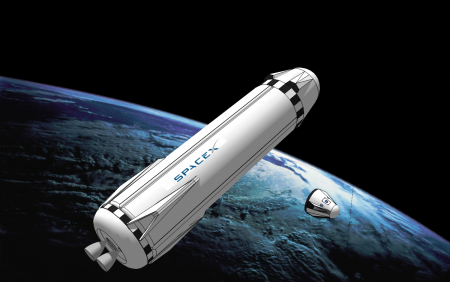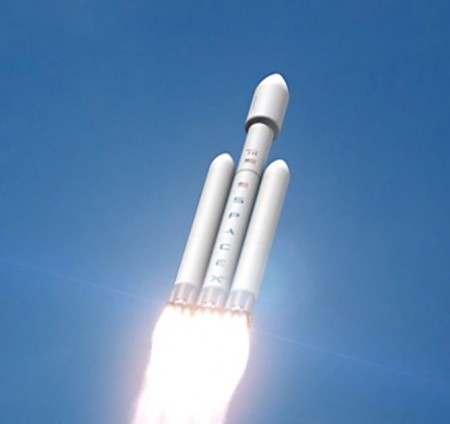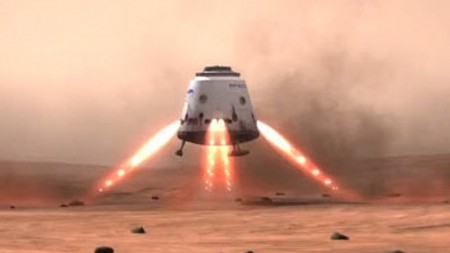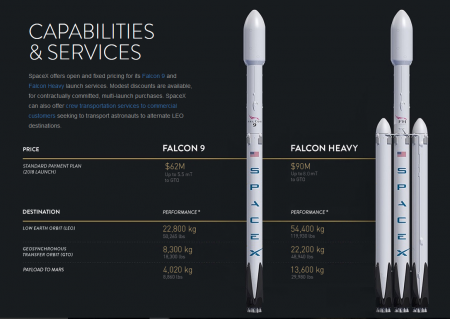April 29, 2016 – The commercial space company SpaceX announced this week it intends to send one of its Dragon capsules on a voyage to Mars in 2018 with the support of NASA. The moniker for the spacecraft will be Red Dragon and the plan will be to launch the capsule from Earth atop a Falcon Heavy rocket. The first Falcon Heavy flight (see picture below), a triple-booster version of the Falcon 9 will happen in November of this year.
The Red Dragon flight will be in 2018. The capsule technology will largely be based on the Dragon 2.0 design which features an 8-pack of Super Draco rocket thrusters capable of completing controlled descent to the surface of the planet.
What is NASA’s role in the mission?
NASA will help SpaceX by providing technical support including Deep Space communication and navigation, flight systems engineering, and planetary protection to ensure no microbial Earth life forms end up contaminating Mars. From the mission NASA hopes to gain a considerable amount of data for future Martian expeditions.
Elon Musk, the CEO of SpaceX, has made it absolutely clear that it his intention to establish a human colony on Mars sometime during the 2020s. His motivation is the preservation of our species by going what he calls multi-planetary. The Red Dragon is not the vehicle of choice for human colonization. Its interior space is no bigger than a typical sport utility vehicle and on the long voyage to Mars would be insufficient to support a human crew. Instead SpaceX is in the process of completing the architecture for what it is calling the Mars Colonial Transporter (MCT). Part of the SpaceX plan for the MCT (see artist’s rendition in the illustration below is to use a refueled Falcon Heavy second stage in the configuration. Refueling would be done in Earth orbit, something yet to be attempted by NASA or any other space faring agency or country.
Currently Space X is the only commercial space company with a capsule designed for payloads and human missions that combines propulsive landing capability with the more traditional heat shield and parachutes used by the United States, Russia and China. The latter two are ineffective for a Mars landing. In fact landing payloads on Mars has been a challenge for NASA. The thin atmosphere has little braking capacity to slow down a spacecraft traveling at supersonic speeds. That’s why the NASA rover missions to Mars were delivered by unconventional means. Opportunity and Spirit were literally dropped to the surface encapsulated in an inflated bubble that bounced to an eventual landing on the planet’s surface. Curiosity deployed a sky crane and used tethers along with a descent capsule firing its rocket thrusters to lower itself to the Martian surface. In a human mission the payloads would be much heavier so a propulsive technology is seen as the most effective approach to a Martian landing, or for that matter landings on almost any body within the Solar System.
Dragon 2.0 can do this and deliver between two and four tons of payload to the surface of Mars. Musk has recently stated, “with Dragon launched on a Falcon Heavy, it can go pretty much anywhere in the solar system.” There are even some preliminary landing sites picked out in the Martian Northern Hemisphere for the 2018 mission.
What kind of payload will be aboard Red Dragon? Will it include a rover? Or is that even important? For NASA a deployable payload is of little concern. The primary question the mission will answer is whether Red Dragon can perform as a feasible and inexpensive Mars lander capable of aerodynamic supersonic deceleration to a controlled landing. If it can then SpaceX will have produced the first interplanetary spaceship similar to the ones we have read about in science fiction.
In a NASA document describing the Discovery Missions and Red Dragon it concludes “the capsule’s design already includes most of the capabilities necessary for Mars missions. Options exist to integrate payloads with the vehicle and….current analysis indicates that entry, descent, and landing of the capsule at Mars is feasible, and the capsule’s descent technique would lead on a path toward human-mission landers.”
Welcome to the age of Buck Rogers.
A Postscript to this article:
In the last week SpaceX has posted on their website “payload to Mars” pricing. Using a Falcon 9 launcher, for $62 million you can deliver a 4,020 kilograms (8,860 pounds) payload to Mars. And if you have a bigger payload requirement, $90 million buys you the Falcon Heavy and 13,600 kilograms (29,980 pounds) of payload to the Red Planet.
This isn’t a seat sale but the page notes that discounts are available for those committed to a multiple launch schedule. Got to love the moxie.





















